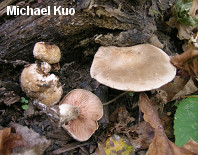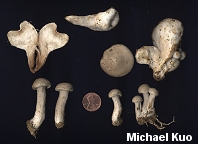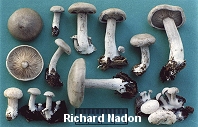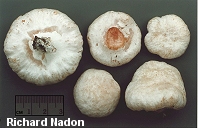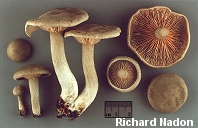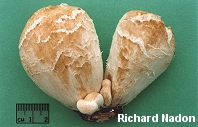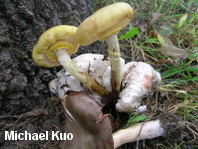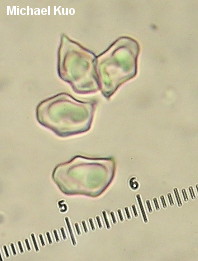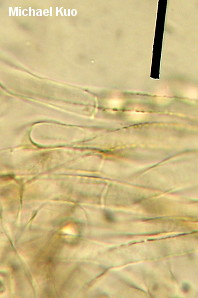| Major Groups > Mycotrophs > Entoloma abortivum |
| Major Groups > Gilled Mushrooms > Pink-Spored > Entolomatoid Mushrooms > Entoloma abortivum |

|
Entoloma abortivum [Basidiomycota > Agaricales > Entolomataceae > Entoloma . . . ] by Michael Kuo Entoloma abortivum is a steely gray entolomatoid mushroom found near decaying wood in eastern North America's hardwood forests. It features a cap that is at first convex with an inrolled margin, and later more or less flat. The gills are grayish at first, but become pink with maturity, and they usually begin to run down the stem. The odor and taste are strongly farinaceous (Mycologese for "like grain meal or watermelon rind"). Microscopic features include 5- to 8-sided, angular spores, and a lack of hymenial cystidia. If these features were all one had to go on, Entoloma abortivum would blend in with the hordes of unidentifiable, boring, brown and gray species of Entoloma on our continent . . . but this species is usually found in the act of parasitizing another mushroom (a species of Armillaria) and, as a result, lumpy masses of tissue are often found alongside the boring gray mushrooms, making identification easy. For over a hundred years it was believed that the lumpy masses of tissue represented an "aborted" form of the Entoloma--like a mushroom that never happened--as the species name suggests. In the seventies, however, mycologists suggested that the masses of tissue might result from parasitizing action on the part of the mycelium of Armillaria mellea. But more recent research (Czederpiltz, Volk & Burdsall, 2001) has turned this idea on its head, suggesting that Entoloma abortivum is the parasite, and Armillaria mellea the victim! See the comments below for the whole story. Description: Ecology: Parasitic on species of Armillaria, and probably also saprobic on woody debris and leaf litter, growing scattered or gregariously near decaying wood in hardwood forests, or in leaf litter near decaying wood; often encountered with Armillaria species fruiting in the vicinity; late summer and fall; widely distributed east of the Rocky Mountains. "Aborted" Form: An irregular glob of tissue 2-10 cm high; surface whitish, discoloring brownish; with white and pinkish areas inside; microscopically containing hyphae from Entoloma abortivum and Armillaria species. Cap: 2-8 cm; convex with an inrolled margin, expanding to flat, broadly convex, with or without a central bump; fairly bald, or with appressed fibers; dry; gray to grayish brown; the margin not lined. Gills: Attached to the stem or, more commonly, beginning to run down it; close or crowded; pale grayish at first, later becoming pink from maturing spores. Stem: 2-8 cm long; 0.5-1.5 cm thick; occasionally somewhat off-center; typically with an enlarged base; solid; bald or finely hairy; with white basal mycelium and threads. Flesh: Thick; white; unchanging when sliced. Odor and Taste: Strongly mealy. Spore Print: Pink. Microscopic Features: Spores 8-10 x 4-6 µ; heterodiametric; 5- to 8-sided. Hymenial cystidia absent. Pileipellis a cutis; elements 4-10 µ wide, hyaline to brownish in 10% ammonia, smooth or encrusted. Clamp connections absent (but reported as present by Hesler, 1967). REFERENCES: (Berkeley & M. A. Curtis, 1859) Donk, 1949. (Hesler, 1967; Smith, Smith & Weber, 1979; Weber & Smith, 1985; Phillips, 1991/2005; Lincoff, 1992; Metzler & Metzler, 1992; Czederpiltz, Volk & Burdsall, 2001; Roody, 2003; McNeil, 2006; Miller & Miller, 2006; Kuo & Methven, 2010.) Herb. Kuo 10090302, 10210902. Will the Real Parasite Please Stand Up? Over a hundred years ago, Charles Peck (1893, p. 54) reported finding Armillaria mushrooms curiously "aborted" like specimens of Entoloma abortivum. In fact, Peck found these aborted Armillaria specimens to be "in no way distinguishable" from aborted forms of Entoloma abortivum. Over the years, others noted aborted, Entoloma abortivum-like forms of Armillaria species--and who knows how many collectors noticed that Entoloma abortivum tended to fruit in the vicinity of Armillaria species . . . but it apparently occurred to no one that there might be a relationship between the two mushrooms. In 1974, Watling studied "aborted" Entoloma abortivum specimens and discovered that Armillaria mellea cells were present in the tissues. He concluded that Armillaria mellea parasitizes Entoloma abortivum. Though Watling did not scientifically prove this idea, "[t]he hypothesis that Armillaria could be a mycoparasite seemed plausible to many mycologists because Armillaria is a notorious pathogen of a wide variety of gymnosperms and angiosperms" (Czederpiltz, Volk & Burdsall, p. 842). Field guide treatments of the "aborted entoloma" published after Watling's discovery accept the hypothesis that Armillaria species attack Entoloma abortivum. However, a study in 2001 by Czederpiltz, Volk & Burdsall found the exact opposite to be true. Using culture studies and field observations, these mycologists suggest that "aborted entoloma" fruitings "represent malformed Armillaria fruiting bodies permeated by E. abortivum hyphae," and recommend the use of the common name "abortive entoloma" to indicate the aggressive, rather than passive, role played by Entoloma abortivum. This site contains no information about the edibility or toxicity of mushrooms. |
© MushroomExpert.Com |
|
Cite this page as: Kuo, M. (2014, January). Entoloma abortivum. Retrieved from the MushroomExpert.Com Web site: http://www.mushroomexpert.com/entoloma_abortivum.html |
